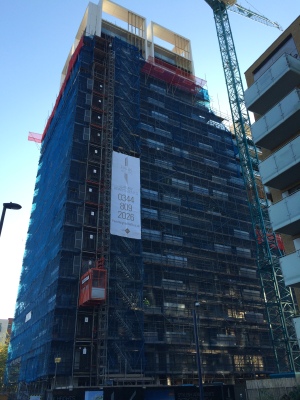How HIUs can help in the commissioning process

Commissioning is the key to ensuring that every heat interface unit (HIU) in a district-heating system delivers. Neil Parry of Altecnic discusses the issues involved.
There are many misconceptions in the building and construction industry about district heating, heat networks and central plant systems. Today’s systems bear little resemblance to past incarnation in terms of commissioning or performance.
Building-services products have developed rapidly but system design hasn’t kept up. It is working to older, out-dated ideas that create problems today.
Older systems required the whole network to be balanced (using commissioning sets or double regulating valves) to ensure even energy supply across the network. Valves close to the plant-room were throttled down ‘forcing’ water up to the higher, least-favoured floors. This ‘commissioning’ was extremely time consuming, often taking a number of weeks to complete.
Today’s variable-volume, variable-speed pumping systems mean this approach doesn’t work. As the plant-room pump increases speed, the flow rate through the static balancing valve increases, and the system goes out of balance. It is only balanced at one pump speed and, for an efficient system, we need the pump operating over as wide a speed range or modulating range as possible.
At high demand, the pump needs to speed up.
At lower demand, the pump must throttle down to minimise pumping costs. This reduces system pressure, ensures wide system ∆Ts and minimal heat build-up.
Correct selection of valves in the primary system overcomes these problems. Constant-flow regulators, including Altecnic’s Autoflow, differential-pressure control valves (DPCVs) or pressure-independent control valves (PICVs) are better suited to variable-volume systems. These valves react to changes in differential pressure to ensure that the system stays in balance.
Crucially, these valves dramatically reduce commissioning time. Traditionally, it used to take a couple of weeks or longer to balance a system, but a system can now be brought into operation in a couple of days.
Incorporating these valves into the HIUs (heat interface units) of heating systems itself reduces the primary system to a simple installation of pipe and isolation valve. Unfortunately many HIUs on the market use fundamentally different control methods, meaning they will need other forms of control on the primary system or a completely different design to overcome HIU inadequacies.
For example, Altecnic’s SATK range of electronic HIUs include, as standard, PICVs that modulate to hold secondary temperatures stable, regardless of changes to the plant-room pump speed. Commissioning then becomes a simple task of checking that the furthest HIU(s) on the network have the minimum differential pressure to operate.
All HIUs need enough pressure to overcome their internal resistance when on full output. This differential-pressure requirement can be calculated all the way back from the furthest HIU on the network to the plant-room (increasing pressure as you go), establishing the required differential pressure at the pumps.

However, this usually results in pumps running far harder than necessary, reducing turn-down ratio, with many negative effects on the system. Pump running costs increase, system ∆Ts are reduced, the value of any renewable source will be reduced, overheating of the building can occur and, potentially, if running excessively hard, control valves can lose their authority. If the calculation is not high enough or the reaction times are too slow, HIUs at the extremity of the system can be starved of energy, and tenants will complain about a lack of hot water.
Resolving these issues is simple; plant-room pumps should be controlled from the furthest point in the system — immediately ahead of the index apartment(s). Controlled from the index, pumps need only be set to hold the differential pressure constant at this point to match the requirement of the installed HIU.
The layout and valving of Altecnic HIUs mean they requires a very low differential pressure (35 kPa). Therefore, pumps can be set to hold 35 kPa at the furthest apartment, speeding up and slowing down for system demand, but always holding a stable 35 kPa ahead of the index apartment.
Accordingly, the index apartment will always have the minimum required differential pressure, and every HIU on the network will have at least this figure, increasing as you get closer to the plant-room. Crucially, the pumps will run at the lowest speed possible in all scenarios, maximising system operating efficiency. With a differential press of 35 kPa, an Altecnic HIU will constantly produce DHW, so there’s now little point to checking any primary flow rates on the network. When 80% of the cost of a building is in its operation, you can see how important this is.
When we come to the commissioning the HIU itself, we see that the latest generation electronic HIUs have major advantages over the traditional mechanical units in terms of the speed of bringing them into operation. With a mechanical HIU, setting the DHW output temperature requires continually adjusting the control valve while checking the temperature at the tap with a thermometer. This is either a 2-man job or trial-and-error process with one person walking between the HIU and DHW outlets, constantly adjusting the control valve.
For radiator circuits, it’s either a vague ‘hand on the pipe, is it hot enough?’ test, or additional thermal equipment is required.
With an electronic HIU, the process is massively simplified and faster. Electronic controllers on the HIU digitally display temperature set points, and accepting the defaults completes commissioning. Changing setpoints simply requires a simple adjustment on the controller.
Altecnic SATK30103 HIUs were recently installed at the £28 million Wayland House development in Stockwell Park, London. Constructed by Wates Living Space, it is arranged as two connecting blocks. The 15storey tower contains 84 affordable apartments that are available for rent. The 20-storey tower contains 75 properties for private sale.
Throughout the design phase of the project and through to completion, Altecnic worked closely with the contractor, helping to select the correct pipework and valves and give advice on design and energy centre sizing. This close collaboration ensured a smooth installation and commissioning process and, ultimately, maximum benefit for residents.
Neil Parry is national specification manager with Altecnic.







